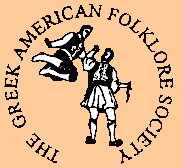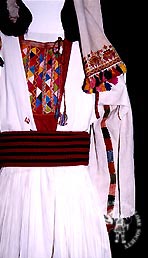
Tilos
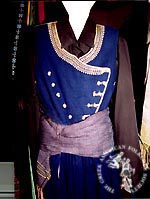
Crete
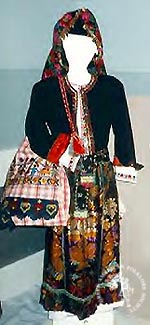
Karpathos: Olymbos
These costumes are still worn by the villagers and they represent significant stages of their life.
The sakofoustano (the first costume) is the unmarried woman's version. The girls from an early age dress in this for everyday or festive occasions. Originally, the preferred material was oriental silk, brocade with a busy floral design on it. Nowadays, they still use similar prints, and the same colors but they choose fabric with more freedom. The costume consists of a pleated skirt and vast ornamentation (about 25 centimeters wide) around the hem comprised of bright colored ribbons, rick-racks, and as we can see on the newer version, sequins. The blouse-like top is also heavily pleated on the front and the lower part of the back. The adornment on the bosom is very similar to that of the hem. The belt is sewn onto the blouse and also decorated. In time, the hand-crocheted lace has been replaced with manufactured lace and has come to border the hem. The apron is worn over the skirt, but underneath the blouse. The large white scarf, the mantili, which comprises the headpiece has a crocheted edge with sequins and small beads. It is tied in such a way that the floral design on it shows at all times.
The newly wed woman's costume is the same as the unmarried except that she also wears a black overcoat, the kavadi, and they trade in their white mantili for a black one. They are supposed to wear this for the first 40 days after the wedding, after which they take off their fancy, shinny sakofoustano and replace it with a simple, cotton chemise. In the opening of the chemise and around the neck and sleeves, they use a small cross-stitch rose embroidery.
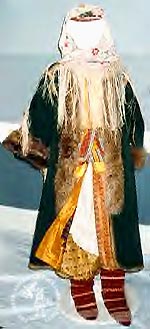
Kastellorizo
Setting sail from their small dry island, the wealthy sea captains, merchants and sailors of the island of Kastellorizo were able to reach all the Mediterranean ports. Their return home was marked by many expensive gifts they brought their wives. When worn, these gifts would serve as sign of their wealth. Their jewelry consisted of bracelets which often reached up to their elbows. Most of the women also wore 2-3 rings on each finger. In order to show them, they would cross their hands in front of their chest. Thus we find, on this small island, an impressive costume, rich in decorations which were worn from the day of the engagement until the woman's senior years, during celebrations and daily activities. The costume served as a statement that even if they became old they were rich enough to have another one made.
The kondovratsi, a kind of short bloomers, is gathered at the waist by the vrakozoni and ends below the knees. The opening of the white chemise is secured with buckles, the so- called voukles, usually six in number. The kavadi or chrysos sakkos is a kind of dress open down the front. A sash, the zooms, is draped around the hips. The costume includes the gouna, a costly overcoat, trimmed with fur, or the kondochi, a similar, but shorter version of it. We present both versions. the head-dress consists of a small cap, the raxini, which is encircled by the band-like tsaki. Both are covered by the krepi, a large silk shawl of Chinese or Spanish make.
Ioanna Papantoniou
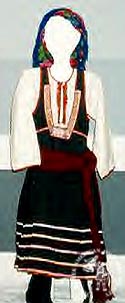
Rhodes
The woman's costume consists of a hand woven white cotton chemise, embroidered with light-colored threads at the hem line. A black cotton or silk-finished dress is worn over the chemise. The dress is fitted at the bosom, but pleated and free-flowing at the skirt. The skirt is decorated with rows of bright green, yellow and red ribbons. A hand woven, dark maroon sash is tied around the waist. The head scarf, either blue, green or red brocade, is folded into a triangle shape and tied around the head in such an intricate manner that the shape of a rose appears at the side of the head. The women purchased these scarves in the Agora from Carpatheans. Beneath the scarf a small cotton cap is worn. The leather boots are of an unusual construction; two colors are used: the bottom half of the boot is beige and the upper part is black. Originally, the boots were embroidered, later, however, colored threads were used instead within the seams. Rows of gold coins may be hung from the shoulders down to the knees for a bride to show her dowry.
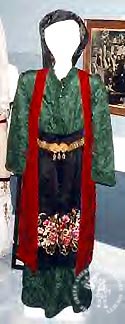
Zagori
The villages of Zagori that cling to the sides of Mount Pindos, and to which access was difficult to prevent invasion, developed undisturbed a high standard of living during the difficult years of Turkish occupation, when the inhabitants of the towns and plains were suffering considerable hardship. According to the earliest information available regarding their costume, it was a bourgeois style, originally oriental but later western in character. It was worn in 46 villages with some variations.
The flokata, the sleeveless overdress of the sigouni type is the only traditional feature of the costume. The other components of the dress have been influenced by the fashion prevailing at the end of the 19th century. Made of thick woolen fabric, the flokata was ornamented with red ribbons, panels of red felt and embroidered patterns of red twisted cord. The two rectangular panels of red felt at the sides of the overdress are called spatela. The black apron is embroidered with bright flowers and the edge with knitted black lace on the hem. The jewelry is an ornamental belt-buckle. A black printed head-kerchief is tied in a special manner, known as oura mantili. In 1991, Paul Ginis traveled to the island of Tilos to conduct his research. Mr. Ginis observed the women still wearing this costume, signing their traditional songs and dancing their traditional dances.
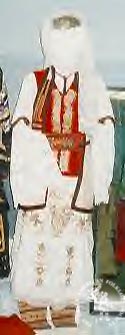
Dropolis
The costume of Dropolis was worn in the region of Dryinoupolis-Dropolis, in the villages of the flat lands surrounding Argyrokastro. This area has close relations with the region of Pogoni, thus explaining many of the similarities noticeable in the costumes, with as principal characteristic the white segouni and all the basic features of the Greek costume. Throughout this geographical area, such as in Lidzouria, Zagora, Delvino, Tepeleni and Premeti, are maintained the manners, habits and traditional customs which demonstrate an interrupted course of Greek heritage.
The women of Dropolis like those of Hassia and other regions tattooed a cross on their forehead as a protection against Moslem dervishes.
The costume, either everyday or festival or bridal wear, consisted of the white cotton, or a silk chemise, skirt, a substitute for the usual dickey, bib or a white summer mantel, sleeveless vest, an apron, wool belt, a golden belt, knitted white stockings. To the headdress belong a red, velvet fez, silk veil, crepe kerchief, a white band tied to the head and a white cotton kerchief. The ornaments of the costume are small silver clasps, cross, silver plated buckle, chains for the chest, earrings, rings and bracelets.
Benaki Museum
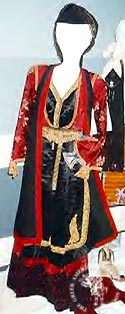
Metsovo
Metsovo was inhabited by Vlachs, who originated from an area known to us today as Romania. The Vlachs were a nomadic tribe, that moved slowly to the south. Upon reaching the Metsovo area, they ceased their wandering and decided to settle there.
The costume shown here is similar to the costumes worn in the Zagori and Konitsa regions of Epirus and was also worn as a bridal costume or on other special occasions. The costume consists of a long dress made of oriental silk. Rich velvet fabric is cut out in a floral-like pattern and applied to the hem of the dress, revealing the silk fabric beneath it. This western style of dress included a dark-colored apron, hand-embroidered with colored silk thread along the bottom hem line. The overcoat, the flokata, unlike its western counterpart, was originally patterned after a "villager's" overcoat. In present day, it is narrower and of a more elegant design, truly complementing the dress beneath it. The woman's hair is braided and covered with a silk scarf, originally tied at the back. Today the scarf is tied over the head. A silver filigree belt is worn around the waist. Rows of gold coins adorn the bosom. Hand-knit, white, wool stockings and flat-laced shoes of black leather are also worn.
Ioanna Papantoniou
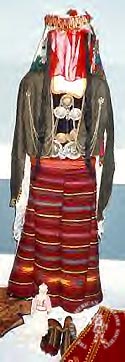
Pogoni
The region of Pogoni is spread over valleys and plateaus in the northern part of Epiros, beyond ancient Dodoni, extending as far an imaginary line separating it from the villages of Dropoli. The infertile cornfields and vineyards obliged the men of the area to seek their fortune elsewhere, some finding work and others left to their own devices, the women worked the fields and vineyards.
The same outfit, with one or two variations, was worn in thirty villages. The costume of Pogoni is composed of the following pieces: the undershirt, chemise, a good coat made of wool from Constantinople or an everyday one, jacket, the pesili of the bride, extra sleeves, belt, mantel with the sleeves, apron, kerchief for the waist of the bride, stockings, knee socks, shoes. The everyday and festival headdress is the obola. The bridal headdress consists of a silk kerchief or red fez, silk tassels, added hair, a white, silk kerchief, a fine red kerchief. Rich ornaments complete the headdress: an ornament of the forehead, earrings, silver ornaments for the top of the head and chains with coins. Ornaments of the costume are buttons, a chest ornament, buckle, dickey, bracelets and rings.
Benaki Museum
Dora Stratou Theater
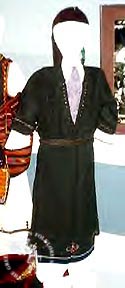
Psaradhes
The Psaradhes region is among the very few regions in modern-day Greece, where many women still continue to wear their every-day folk dress and even their festival costume. The cotton chemise worn, similar in form to all chemises belonging to costumes using the siguni, are characterized by the old, traditional motifs sewn with the same stitches as found in the embroideries of Macedonia, Epirus, Thessaly, Attica, Boeotia and Euboea. In the past, the costume of the villages around Lake Prespa, Agios Germanos and Psaradhes was all white. Around the years 1930-1935, the women replaced the all-white bridal and festival costume with a black siguni and dark-colored apron, worn later only by middle-aged women. A decorative dickey, the tracila, draped over the bosom. A black, woolen, elbow-length overcoat was also worn. An apron, made of either black wool, a dark-colored velvet or brocade material, adorned with silver coins, tied over the waist and overcoat. Black stockings were always worn and a printed black scarf adorned the head. To accent the costume, pearls were worn around the neck; silver coins draped from the bosom down to the waist and up to the shoulders; and silver chains were used to grace the aprons.
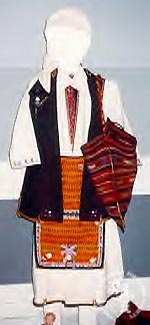
Florina: Aghia Paraskevi
The women's costume of Aghia Paraskevi is similar in style to the costumes of the surrounding villages. The white chemise is hand spun and woven from cotton, embroidered with a fine woolen thread around the hem line. Two heavier panels are added to the bottom of the back side only. The front of the chemise is open to just above the waistline revealing the dickey (or bib). The dickey is bordered by a simple piece of floral-patterned cotton and tied around the neck. The sleeveless overcoat is worn over the chemise and dickey. The overcoat, black in color, was white prior to the 1920's. However, there was a period of time where both colors were used. The cord-work on the overcoat is made with yellow and red threads. It is a very simple design, but because of the colors it is very appealing. The apron is a woven masterpiece. The pattern design is very complicated and is woven with red, yellow and black threads. The edges are adorned with ribbons and coins. The pattern design of the hand-knit leggings is also very complicated and is made using the same color scheme as the apron. The plain white scarf is folded in a triangle shape. The corner hangs down the back to just beneath the waistline, and is trimmed with coins and long fringes, embroidered with woolen or silk threads.
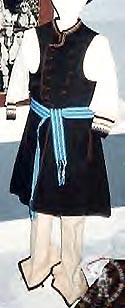
Alona
The male costume of Alona is similar to the male costume found in both Akritas and Psaradhes. Generally, this costume style, with some variations made to it, is found throughout the region of Florina, Western Macedonia.
The cotton undershirt hangs to just above the knee and is embroidered around the collar. Beneath the undershirt, unattached sleeves cover the forearm, and may also be embroidered if so desired. A sleeveless, black, woolen overcoat, the kiourdia, is also worn but not in the summer months.
In Alona, as in the other areas of Macedonia, the old red hat or fesi has been replaced by a black toque of astrakhan or plush, the kape.
This costume has served as model for the uniform of the Macedonian Fighters.
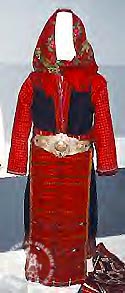
Orini
Orini consists of two villages, neighboring each other, known as Orini and Ano Orini. Both are mountainous villages, as their names imply - earlier they were known as the Phrastena - with Orini situated at an altitude of 750 meters and Ano Orini at 820 meters.
The mountainous situation of the two villages, the agricultural nature of their economy, the restricted, "closed" life of the villagers and the absence of tourism - the road from Serres to the villages is for the most part only roughly paved - all have contributed effectively to the preservation of the villagers' traditional modes of life.
Women's costumes of Orini, Ano Orini, and Xirotopos, Serres, are characterized by the same basic elements that make up the majority of village costumes in the Balkans (underdress, middle dress, overcoat, sash, apron, stockings and head kerchief). Visually, they immediately call to mind the costumes of Volakas, Drama and of those villages sharing similar costumes (Xiropotamos, Monastiraki etc.) Like all of the costumes of Greece, they differ according to the circumstances under which they worn (i.e. denoting every day wear, to mark festive or nuptial occasions, to denote single or married status). The kouralak, a small round box dressed with material of some kind and worn on the crown of the head, is an important accessory to the bridal headdress.
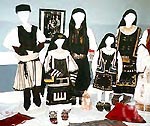
Thrace, Thessaly, Epirus: The Sarakatsani Nomads
The Sarakatsani people are semi-nomadic stock farmers with true Greek origins, their roots lost deep within the bygone centuries. All expressions of their way of life are attached to very old traditions. Their flocks, their only possession and source of their sustenance, determine the unchangeable rhythm of their life revolving around the uninterrupted movement toward better pastures.
the Sarakatsani of the Pindus range spread out in every direction, to the Adriatic and Ionian Seas, Macedonia and Thessaly, until eventually populating the plains of the whole of the Greek mainland, reaching Attica, Euboea and northern Peloponnese.
In the final development of the costume, we notice two basic kinds. The first was worn by the Sarakatsani who were scattered over western Macedonia, Epirus, Thessaly, Sterea, as far as Attica and Euboea and the northern Peloponnese and is characterized by a frugal simplicity. The second kind was worn by the Sarakatsani who passed the winter in central and eastern Macedonia, the Serres and Kavala area, as well the mountainous region of Paranestion Rodopis.
Benaki Museum
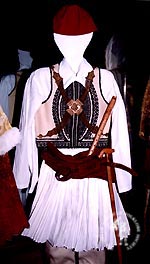
Central Greece & the Peloponnese: The Town Costume, Foustanela
The costume called Foustanela, established by Otto, the first King of Greece, as the formal court dress in the middle of the 19th century, prevailed in the urban centers of Moreas (Peloponnese) and Roumeli (Central Greece). This dress was originally the military outfit of the Greek chieftains.
The costume was soon modified by the men for holidays and other festive occasions. The outfit that is shown here has two jackets, the inner waist coat, the yileki, and a second sleeved short jacket, the fenneli, with the sleeves falling freely over the back.
The material that was used for this version. is wool. The embroidery is made of spun wool and the belt is of a fine leather work.
The Foustanela has changed in the meaning of detailed work, the length of the fousta, and, sometimes, the number of jackets worn. The sleeves have become decorative, resembling wings without the function of sleeves. After all the changes, it has become the standard Pan-Hellenic male costume used to the modern times.
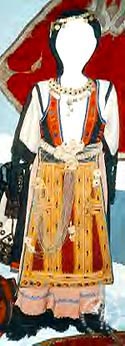
Thessaly: The Karagounian Costume
There has not yet been a definitive interpretation of the name "Karagounis". N.A. Veis writes it derives from kara ("black" in Turkish) and gouna ("coat") which, however, is not a part of their costume, while N. Eleftherides writes that it derives from karayiounan, a compound word from the Turkish kara and the Greek name Ionas, which in Persian becomes yiounan from Iaoun (Iaon, Ion) and is used generally to mean Greek.
The bridal costume worn in the Thessalian plain is still used in our days in a modified and simplified version. It has a chemise, the linomaniko poukamiso, edged with a thick black fringe on the hem and sleeves. The diplos sayias consists of two cotton dresses. The outer dress, which is usually of indigo-blue color, has many folds and an added border sewn upon the hem, with embroidered patterns matching those of the short waistcoat, the yileki. The front of the bust is covered by a dickey of cotton material. The costume includes an apron of felt, and an apron made of silk. The kavadomanika, which are ornamental arm-bends, are worn over the sleeves. The head is dressed with false plaits and a cotton or silk kerchief. The costume is accompanied by a great many ornaments. The winter version of the costume has a heavy overcoat made of black wool.
Benaki Museum
Ioanna Papantoniou
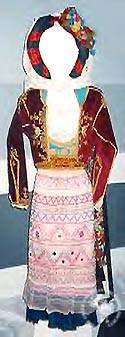
Ionian Islands: Kerkyra (Corfu), Lefkimmi
Corfu (Kerkyra) is the northern-most of the Ionian Islands, the island of the Phaeacians. Although a half-way station between Italy and Greece, it was influenced by the village-style of costume of the neighboring mainland rather than the urban dress, as was the case with smaller centers in the rest of Greece. However, the headpiece shows some relationship with the headpieces of the Medieval age.
The white chemise and the white petticoat serve as under-garments. The outer skirt was most of the time fashioned of taffeta. the front of the bust is covered by the boustina, a white embroidered dickey. The waist is girded by the chrysozonior chrysokimero, which was partly covered by a small sleeveless waistcoat, the tzipouni, held in place with false gold buttons. The bridal apron, the velenia, is made of either silk fabric or of tulle ornamented with multicolored trimmings. The costume includes a sleeved jacket, the peseli or kremezo. The ornate bridal head-dress, known as stolos or yadema, is largely based on the coiffure: the hair is arranged in a kind of crown, coiled around four tube- like hair-pads, which are wrapped in red ribbons.
Ioanna Papantoniou
Dora Stratou Theater
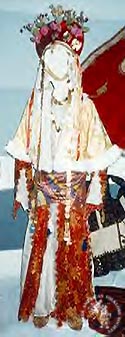
Palea Athina - Old Athens: The Bridal Costume
OLD ATHENS: THE BRIDAL COSTUME
The girl's costume, particularly her festival one, is composed of pieces with a very old formal tradition. The matchmaking process began when the children were still very young. Care was taken to ensure that both children were in the same social class. During the engagement and right up to the wedding the young people never met; they did, however, exchange gifts. What the girl's dowry contained depended on her social class and wealth. When the time came, the bridal outfit was prepared. The bride's hair was washed with henna, then it was braided into small plaits (about 40). Gold and silk thread the color of the bride's hair was woven into it. Her female relatives helped the bride put on her very expensive bridal outfit. They put on the salivari, which was made of gold brocade and silk kamisi with lavish embroidery on the bodice and silk trim with sequins or pearls along the edges. Over this she put the kavadi, made of brocade and ornamented with braid and gold cord, done with consummate craft by tailors. The bride put on the anderi, for the first time. Worn by the richest ones, it was made out of heavy silk brocade, interwoven with gold or silver threads. Over the anderi the bride put around her waist a wide silk belt. A special headpiece, by the stolistra, had to be created for the occasion. First the stolistra put on the gilt, pasting on gold leaf to decorate nearly the entire face. In the middle of her forehead. she put a large gold star and above her eyebrows, following their line, she pasted a series of gold stars, made of gold leaf and bits of gold-bugs. The decorating jewelry belonged to the churches. The korona was fashioned of flexible laminate in the shape of a large crown; it appears that the empty spaces were closed on the inside with red velvet stuck on cardboard. they covered the velvet with coins, flowers, gold and silver.

Thrace: Metaxades
The poor quality of the soil of the Florina plateaus, prevented the local residents from wearing clothing of expensive material. The nearby forest offered some resources, such as timber, charcoal and bee-keeping, but the people lived a life of deprivation and hardship. The women wove their own cotton and woolen cloth from which they sewed their simple, austere dresses. The white cotton chemise was embroidered around the hem line and on the sleeves with colored threads. The opening of the front of the chemise was bordered by brightly-colored fabric. A floral patterned jabot of bought fabric was placed at the opening of the bodice. A black woolen, sleeveless overcoat, the sigouni, was worn over this. This overcoat was embroidered around the neck and on the front with brightly-colored threads. The sash, approximately two meters in length, was made of black wool and tied around the waist at the top of the apron. The black and red apron was always home spun and woven. The simple black scarf, placed upon the head, was adorned with a string of pearls. These pearls were considered to be part of the dowry.



















